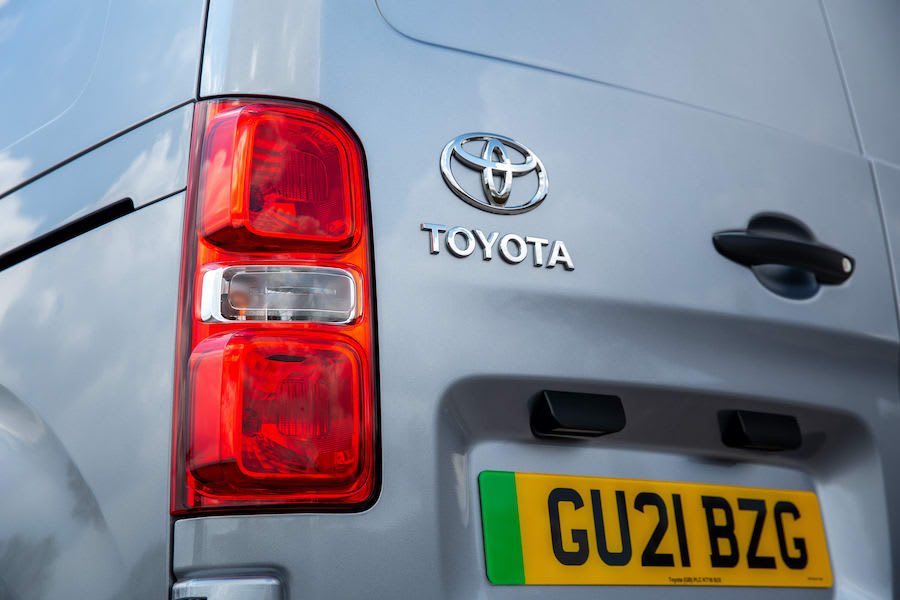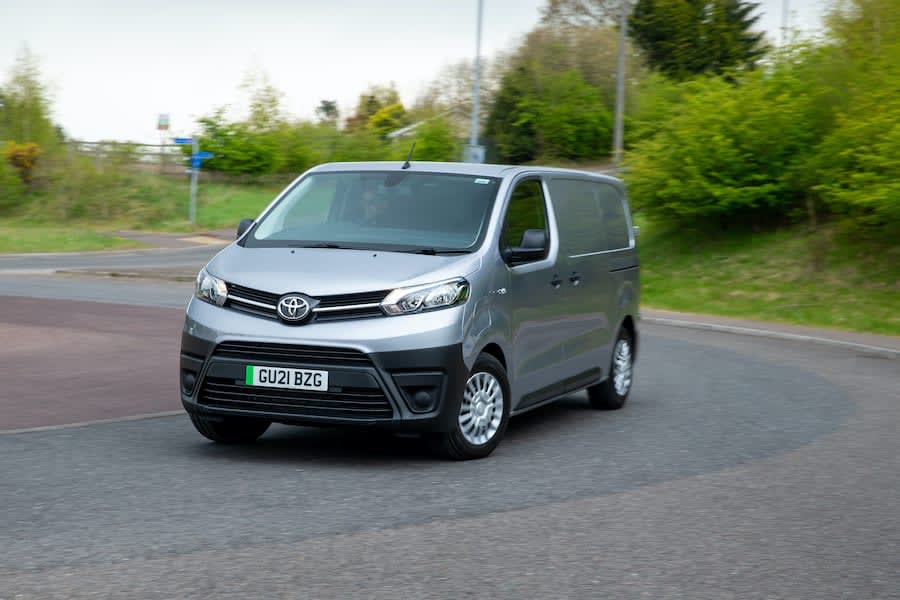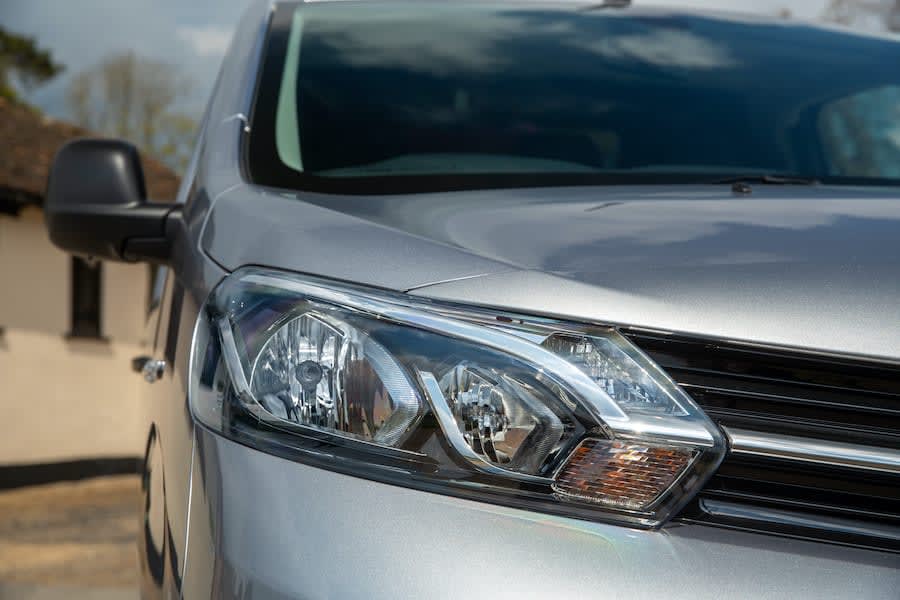.jpg)
Toyota Proace Electric Van Review
.jpg)
Introduction
Toyota is well known for its hybrid technology, but it’s been late to the pure-electric game. While the Prius gets the plaudits (or at least it did until the competition caught up) there’s not been an electric vehicle in its range until now.
And the first Toyota EV? A van. The Proace Electric is a medium-size model that’s designed to appeal to smaller operators who might appreciate a one-size-fits-all offering.
However, it’s mechanically the same van as the Citroen Despatch, Peugeot Expert and Vauxhall Vivaro, sharing the same chassis, body and motors, so has Toyota got anything in its arsenal to attract customers?
Select's rating score* - 4.4 / 5
At a Glance
Toyota has eschewed the fashion for countless variants and created one 4,959mm long van in one trim level. The proportions work well, while the horizontal ‘wing’ on the front of the van adds a sense of style and the extended wheel arches mask much of the boxiness. It’s an attractive van that will look the part for any owner-operator or SME fleet.
All but identical to rivals from Citroen, Peugeot and Vauxhall, Toyota’s laser-like targeting of single unit sales or small fleets means there’s added value from an extensive warranty package and a focus on service.
Beyond that, it’s a pretty conventional but likeable van. If you’re after an electric van for your business, it should be on your list.

Key Features
Let’s skip past the electric motor and battery power, as we’ll come to that in detail later. Instead, it’s the choice of Proace Electric models available that really stands out: there are just two options to pick from, and the only difference is the size of the battery pack.
That makes life refreshingly simple. Rather than try to figure out if you need an L2, L3 or L4 body, or an H1, H2 or H3 roof, or a 90, 120 or 150hp motor, or any of the myriad trim lines available, Toyota has reduced the complexity.
That means there’s just one body length, one roof height, one trim level and one motor. Ok, there are two battery pack options, but then your decision-making process is over.
For the owner-operator and SME customers Toyota is targetting, that is a smart move and gives the brand a point of differentiation against its rivals - something that’s especially important when three of your rivals are all but identical.
For larger fleets and customers with very specific needs, it might be a restriction too far, but the simplicity keeps capital, insurance, repair and conversion costs down.

Performance & Drive
For a van that is likely to spend the majority of its time trundling around the city or wider urban areas, there’s much that’s good about the Proace. The short stubby nose leads to a surprisingly upright windscreen, and they combine to create impressive visibility. Near-vertical sides and clear (if a little small) mirrors mean that you’ll be able to squeeze into gaps or between lines of traffic in a way you’d not manage in many rivals. Relatively compact dimensions help in the urban jungle too, making the Proace an excellent prospect for a courier.
The 136hp electric motor produces 260Nm of torque which, as with every electric vehicle, provides instant acceleration. The surge of power makes it feel more lively than its diesel-powered brethren but, despite the relatively low power output, it’s also at home on the motorway.
Cruise along the highway and the Proace Electric will run out of puff eventually, but you’ll be doing speeds that will attract the attention of the local constabulary before it starts to feel too ponderous. It’ll cruise quite happily at those speeds too, without feeling strained, although that will have a significant impact on the electric range.
That battery pack keeps the weight low down in the van, adding stability and traction you’ll not find in any regular model, which makes country roads tolerable, if not quite enjoyable. Sharper steering would be nice, but that might affect its relaxed motorway demeanour.
That relaxed nature is helped by the electric motor, as it removes the diesel clatter you would normally expect. Vibration-free, the only noise comes from the tyres and wind, but they’re both kept well in check.

Running Costs
In normal circumstances, an electric vehicle is cheaper to run than a diesel model. The same holds here, with the 75kWh battery pack in our test vehicle taking around £12 to fully charge. That’s enough to get you 205 miles, at least officially. Happily, the Proace Electric gets reasonably close to the laboratory tests, with our time in the van suggesting an average of around 170 miles from each charge. You’d have to get 90mpg or so from a diesel model to match those energy costs.
The lower-range 50kWh model might be even cheaper to run, as the lower weight improves efficiency slightly. Additionally, three driving modes work to improve efficiency, holding back power to prevent you from draining the battery too quickly. Happily, when necessary, you can unleash all 136hp.
Range anxiety is always an issue, but the average van covers just 52 miles a day so the Proace Electric has more than enough for a full day's work. Should you run low, and can plug it into a suitable rapid charger, you’ll be able to get an 80% charge in just 48 minutes. It’s possible to charge from a regular three-pin socket, but that’ll take a full 24 hours for a complete charge. A wall box at home or the workplace will cut that down to seven hours, making for easy night-time recharging.
As with every Toyota, the Proace Electric is covered by an exceptional 10-year warranty, although it’s limited to 100,00 miles. You’ll also need to ensure that the van is serviced at a Toyota centre according to its schedule, or you might find the cover expiring. Servicing is required every two years or 15,000 miles. Ignore the servicing criteria and the warranty is limited to three years or 60,000 miles.

Interior and Technology
The cabin in the Proace Electric is a little uninspiring, but perfectly usable. The dashboard is a sombre affair, with little flair, although the gear lever has been replaced by a rocker switch that you use to select forward or reverse gear. That’s the end of the excitement.
Buttons are kept to a minimum, with most functions moved to the 7.0-inch infotainment screen. Shortcut buttons line up on each side of the screen, allowing for quick access to the more frequently used functions, but it’s not the most up to date system.

There is a DAB radio built in though, along with navigation and both Android Auto and Apple CarPlay. However, there’s only one USB socket in the van, so if you’re using Android Auto your passenger won’t be able to charge a phone or run any other device. There’s a tempting shelf by the socket to place your phone, but it’s made of shiny, hard plastic and is a little smaller than you might hope for, so expect to see your expensive smartphone exiting towards the floor at the first corner. A few pence spent on a strip of rubber will solve that problem, though.
Elsewhere, it’s a pleasant enough cabin. The driving position is fine, although taller drivers will find the seat doesn’t go back quite far enough. There’s also a handful of cubby holes and slots to store your daily detritus and paperwork, although perhaps not as much as you’d like.
It is, however, comfortable, which will serve you well on both stop-start courier jobs and longer motorway runs.

Payload and Practicality
With just one body, there’s no chance of picking the wrong model. It does limit maximum capacities so the Proace Electric doesn’t always look great on tables that list vehicles by their load volume, but the van is competitive in its sector.
About the same size as a Volkswagen Transporter, the Proace Electric is a tiny bit under five metres in length, which is enough to slide a load of up to 2,512mm into the load area. Maximum width is 1,628mm while the maximum height is 1,397mm, all of which are figures towards the top of its rivals measurements and, for obvious reasons, all but identical to those you’ll find in the Despatch, Expert or Vivaro.

If maximum volume is your thing, there’s 5.3m3 available, with a little extra available in a load-through hatch under the passenger seat. This allows for unusually long but also unusually compact loads to be slotted through into the cabin, extending the load area temporarily. That slot is, however, usually occupied by the charging cables, so you’ll need to find a home for them if you expect to use the extra capacity.
Access to the cargo area is exceptional, with a pair of rear doors that open through 180 degrees, and a sliding door on both sides of the van. Each is big enough to slide a Euro pallet through, and you’ll be able to squeeze two of them in the back with room to spare.
The ultimate payload capacity of the van is a little limited, with that heavy 75kWh battery pack eating into the allowance and leaving just a tonne to play with. Cust costs, and range expectations, and the 50kWh model will free up another 226kg. Impressively, the Proace Electric is rated to tow a tonne, something that’s unusual for an electric vehicle of any kind.

Safety
Euro NCAP hasn’t started crash testing vans yet but has run the Citroen Despatch through a series of tests to check the safety systems installed. As the Toyota Proace is the same basic vehicle and identically equipped, the same results apply, and they’re not strong.
Awarded a Bronze rating, the tests showed that the van's automatic emergency braking system works, but only to a point. When avoiding or mitigating incidents directly ahead, the system performed well, but anything off to the side impacted performance significantly. The system reacted poorly to children running into the road and failed to identify cyclists.
The van comes fitted with cruise control, a speed limiter, head-up display, hill start assist and stability control, all of which help to make life easier and safer. Vitally, there’s also a solid metal bulkhead to separate the driver and passengers from the cargo area. There’s no option to add further safety equipment, however.

Options
Toyota is certain that one size will fit all with the Proace Electric, so choices are few and far between.
Once you’ve picked which size battery you’d like (either 50kWh or 75kWh), you’re left with little else to choose. There’s just one trim level, the mid-spec Icon grade, but you can paint it in optional metallic paint. There’s also the chance to have some rubber mats put in the cabin, or some plastic lining and anti-slip flooring installed in the cargo area.
And that’s about it. It shouldn’t take more than a couple of minutes to order your new van, then.

Rival Vans
The most obvious rival is the Citroen e-Dispatch. Or the Peugeot e-Expert. Or perhaps the Vauxhall Vivaro-e. All three are virtually identical and form the base of the Toyota Proace Electric. If you’re happy with one, you’ll be happy with any of the others, so it comes down to the best deal for you.
Rivals from Germany look large. The Mercedes-Benz e-Vito is stylish and capable, with a great reputation for comfort and quality, while the Volkswagen ABT e-Transporter is, again, a stylish and capable van with a great reputation for quality. There must be something in the water over there.
The Ford Transit Custom is the biggest selling van, and for good reason. Great to drive, with a spacious cabin and competitive payload and load volume, it’s not yet available as an electric van. However, a plug-in hybrid option is available, which might suit those based outside of the city but needing to travel in.
Verdict
Opting to restrict customers to one model might seem foolhardy, but it’s a mark of how well Toyota knows its customers. Or at least how much it thinks it knows its customers.
The self-employed owner-operators, as well as SME customers, will appreciate the simplicity and the resulting strong residual values that help to keep lease costs low. That said, it’ll still cost more than an equivalent diesel-powered model, but your usage might be able to balance that with lower operating costs and the avoidance of any low-emission zones or congestion zone charges.
Add in the government’s plug-in grant and the Proace Electric starts to make a lot of sense. For now, anyway; the market is moving so quickly towards the inevitable electric future that the next new model might just usurp it.
Where to next?
View latest Toyota Proace Electric Van leasing deals - guide price from £303.87 per month ex VAT**
Looking for a great leasing deal? Check out our incredible range of Special Offers
New medium van? Read our latest Van Reviews and find the right model for you
Want to know more about leasing? Take a look at our comprehensive Van Leasing Guides
Interested in everything motoring? Why not catch up on all the latest Van Leasing News.
*Score based on Select’s unique meta score analysis, taking into account the UK’s top five leading independent car website reviews of the Toyota Proace Electric Van
**Correct as of 06/12/2021. Based on 9 months initial payment, 5,000 miles over a 48 month lease. Initial payment equivalent to 9 monthly payments or £2734.83 - Ts and Cs apply. Credit is subject to status.

.jpg)















